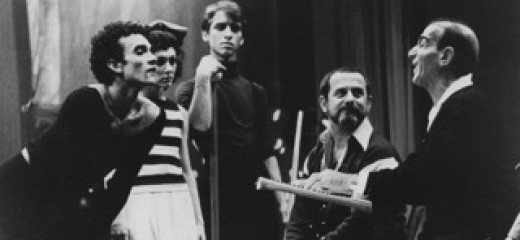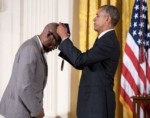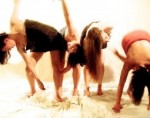
The Hit Parade
by Lisa Bardarson
Parade was produced in 1917 under the aegis of the legendary Ballets Russes and its impresario, Sergei Diaghilev. Diaghilev, a visionary who brought many a groundbreaking artist to the ballet stage (Igor Stravinsky and Léon Bakst, for example), hoped for a hit that would stir the public with the same furor as did Vaslav Nijinsky’s 1912 ballet, L’Apres-midi d’un Faune with its rejection of classical formalism. It’s easy to see why Diaghilev believed that a cubist-inspired work like Parade had the same potential to stir audiences. This multimedia piece featured a unique collaboration of the days’ most avant-garde artists: composer Erik Satie (aged 51), librettist Jean Cocteau (aged 28), and designer of set, costume and make-up Pablo Picasso (aged 36). Léonide Massine, who is widely known for his role as the cobbler in the ballet film The Red Shoes, was a dancer and choreographer for the Ballets Russes and just 21 when he received his choreographic assignment for Parade.
Gay Morris recently presented her research into the creation of Parade to a rapt group of academicians as part of the Dance Studies Colloquium at Temple University. Her investigation, specifically into Massine’s contribution, was prompted by forgotten notes she had written on the subject while in Paris years before. Since rediscovering the notes upon cleaning out a closet, she has been something like an archaeologist at a dig, meticulously exploring the premise that Massine deserved better recognition as an equal amongst his collaborating peers.
As Morris revealed to the gathering in the CHAT Lounge at Gladfelter Hall, Parade has suffered from a dearth of early documentation. Proving that Massine’s avant-garde vision was every bit as informed as that of his more experienced collaborators was challenging, as notes and photos were all that survived from the 1917 production. It’s easy to hear Satie’s music flexing its modernist muscle with edgy crassness and dissonance and to see the exaggerated angles in Picasso’s renderings of the sets, costumes and make-up; they are a feast of cubist distortion.
Thanks to Robert Joffrey’s interest in both historical and new works, a reconstruction of Parade was created for the Joffrey Ballet in 1973. Massine, with only his memory, notes and photographs, reluctantly agreed to reset this masterpiece. And so, fifty-six years later and a continent away, Parade received its American debut at City Center in New York City.
As part of her lecture Morris shared a deteriorated television clip from the Joffrey reconstruction that featured Gary Chryst in the role of the Chinese Conjuror. I could see the two-dimensional angularity in the movement and agreed with Morris that it reflects the spirit of cubism. She also pointed out that the explosive, chunky entrance of Chryst’s leaps used no transitional steps. This choreographic choice challenged the accustomed lyricism of ballet.
Chryst’s performance in this role, which Massine himself danced in 1917, is a magnificent tour-de-force that is worth viewing. In an interview, Chryst recalls how Massine asked him to “flex his cheekbones.” I wondered if this is the type of absurdity that Morris would like to see Massine get credit for. As I observed in the film excerpt from Joffrey: Maverick’s of American Dance, the Conjuror’s exaggerated facial expressions are bizarre and even collage-like.
Just as one can identify that a guitar is a guitar in Picasso’s cubist Guitar Series, I can identify with Morris’s point: Massine’s aesthetic intent was most certainly cubist and he was a fully participating player on the avant-garde playground in which Parade was created.
Massine/Picasso/Parade, Gay Morris, Dance Studies Colloquium at Temple University, Tuesday, October 29, 2013. This free monthly event is held on Tuesdays from 5:30-7:00pm at the CHAT Lounge, Gladfelter Hall, 10th floor, Temple University (main campus). http://www.philadelphiadance.org/calendar/?eID=5998
By Lisa Bardarson
November 10, 2013









